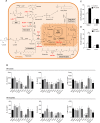Rewiring monocyte glucose metabolism via C-type lectin signaling protects against disseminated candidiasis
- PMID: 28922415
- PMCID: PMC5619837
- DOI: 10.1371/journal.ppat.1006632
Rewiring monocyte glucose metabolism via C-type lectin signaling protects against disseminated candidiasis
Abstract
Monocytes are innate immune cells that play a pivotal role in antifungal immunity, but little is known regarding the cellular metabolic events that regulate their function during infection. Using complementary transcriptomic and immunological studies in human primary monocytes, we show that activation of monocytes by Candida albicans yeast and hyphae was accompanied by metabolic rewiring induced through C-type lectin-signaling pathways. We describe that the innate immune responses against Candida yeast are energy-demanding processes that lead to the mobilization of intracellular metabolite pools and require induction of glucose metabolism, oxidative phosphorylation and glutaminolysis, while responses to hyphae primarily rely on glycolysis. Experimental models of systemic candidiasis models validated a central role for glucose metabolism in anti-Candida immunity, as the impairment of glycolysis led to increased susceptibility in mice. Collectively, these data highlight the importance of understanding the complex network of metabolic responses triggered during infections, and unveil new potential targets for therapeutic approaches against fungal diseases.
Conflict of interest statement
The authors have declared that no competing interests exist.
Figures







References
-
- O’Neill LAJ, Pearce EJ. Immunometabolism governs dendritic cell and macrophage function. J Exp Med [Internet]. 2015. December 22 [cited 2015 Dec 27];213(1):15–23. Available from: http://jem.rupress.org/cgi/content/long/213/1/15 doi: 10.1084/jem.20151570 - DOI - PMC - PubMed
-
- Arts RJW, Joosten LAB, Netea MG. Immunometabolic circuits in trained immunity. Semin Immunol. 2016; - PubMed
-
- Lachmandas E, Beigier-Bompadre M, Cheng S-C, Kumar V, van Laarhoven A, Wang X, et al. Rewiring cellular metabolism via the AKT/mTOR pathway contributes to host defence against Mycobacterium tuberculosis in human and murine cells. Eur J Immunol [Internet]. 2016. November [cited 2016 Nov 14];46(11):2574–86. Available from: http://www.ncbi.nlm.nih.gov/pubmed/27624090 doi: 10.1002/eji.201546259 - DOI - PMC - PubMed
-
- Kelly B, O’Neill LAJ. Metabolic reprogramming in macrophages and dendritic cells in innate immunity. Cell Res [Internet]. 2015. July [cited 2016 Dec 15];25(7):771–84. Available from: http://www.ncbi.nlm.nih.gov/pubmed/26045163 doi: 10.1038/cr.2015.68 - DOI - PMC - PubMed
-
- Tannahill GM, Curtis AM, Adamik J, Palsson-McDermott EM, McGettrick AF, Goel G, et al. Succinate is an inflammatory signal that induces IL-1β through HIF-1α. Nature [Internet]. 2013. March 24 [cited 2016 Nov 30];496(7444):238–42. Available from: http://www.nature.com/doifinder/10.1038/nature11986 - DOI - PMC - PubMed
MeSH terms
Substances
Supplementary concepts
LinkOut - more resources
Full Text Sources
Other Literature Sources
Medical
Molecular Biology Databases

